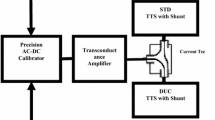Abstract
Low frequency (LF) voltage and current are important parameters in electrical metrology. The standards for LF voltage and current are established by assigning AC–DC transfer difference to thermal devices, i.e. thermal converters or thermal transfer standard along with current shunts. Automated calibration systems have been developed based on Null method and measurement technique developed by Budovsky for calibration of precision calibrator in LF voltage and current against thermal devices. The technique based on the Algorithm developed by Dr. Ilya Budovsky (National Metrology Institute (NMI), Australia) has been compared with the conventional null technique. Indigenously developed software has been used to calibrate the precision calibrator in the entire LF voltage and current range using Holt thermal converters and current shunts. Calibration results at 1 V, 10 V in the frequency range from 10 Hz to 1 MHz as well as calibration results of 1 A in the frequency range from 40 Hz to 10 kHz are presented in this paper. These result shows that the measurement technique developed by Budovsky has reduced the complexity of AC–DC transfer measurements, measurement time and the uncertainty in measurement.










Similar content being viewed by others
References
I. Budovsky, Algorithm and uncertainty of AC–DC transfer measurements, Proc. of Metrology Society of Australia 4th Biennial Conference, Gold Coast, October. (2001) 81–88.
Graphical user interface (GUI), http://en.wikipedia.org/wiki/Graphical_user_interface, Wikipedia, Retrieved 12 January 2010.
Report of APMP Comparison of AC–DC Transfer Difference, APMP-IC-9-95, (1995).
A.K. Govil, S. Ahmad, B. Pal, and P.C. Kothari, Development of an automated AC–DC transfer measurement system for voltage and current at low frequencies, Proceedings of Conference on Precision Electromagnetic Measurements (CPEM) 2008, Biennial Conference, Colorado, USA, June 8–13, (2008) 590–591.
ISO Guide to the expression of uncertainty in measurement, 1993.
B.D. Inglis, Standards for AC–DC transfer, Metrologia, 29 (1992) 191–199.
S.M. Ali Rasha, Comparison between two different designs in the AC voltage measurement, Measurement, 44 (2011) 1539–1542.
M. Halawa, M. Rahal, A step-down technique to calibrate AC current down to 10 µA using a precision 10 mA current shunt, MAPAN-J. Metrol. Soc. India, 27 (3) (2012) 139–142.
M. Halawa, A. Hasan, E.H.Shehab-Eldin, and E.M. EI-Refaee, Integrated calibration system for accurate AC current measurements up to 100 kHz, MAPAN-J. Metrol. Soc. India, 27 (3) (2012) 143–148.
Acknowledgments
We are thankful to Prof. R.C. Budhani, Director National Physical Laboratory India for encouragement and permission to publish this work. We also like to thank all the authors whose published work and reports have been referred in this paper.
Author information
Authors and Affiliations
Corresponding author
Rights and permissions
About this article
Cite this article
Pal, B., Ahmad, S. & Govil, A.K. Automation and Evaluation of Two Different Techniques to Calibrate Precision Calibrators for Low Frequency Voltage Using Thermal Devices. MAPAN 28, 31–36 (2013). https://doi.org/10.1007/s12647-012-0038-5
Received:
Accepted:
Published:
Issue Date:
DOI: https://doi.org/10.1007/s12647-012-0038-5




